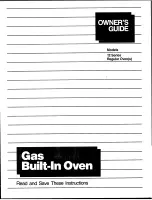
66
Roasting
m
There is a risk of injury if you use roasting dishes that
are not heat-resistant!
Only use roasting dishes that are marked as being suitable for
use in the oven.
Do not use shelf height 2 when roasting with
3
Hot air. This will
adversely affect air circulation and your roasting results will not
be as good.
Open roasting
For open roasting, a roasting dish without a lid is used.
When you are roasting with
%
Top/bottom heat, you should
turn the roast approximately half to two thirds of the way
through the roasting time.
Roasting in the universal pan
Juices escape from the roasting meat and are collected in the
universal pan. You can use these juices as the basis for a tasty
gravy.
You can also cook side dishes (e.g. vegetables) at the same
time as roasting meat in the universal pan.
For smaller joints, you can use a smaller roasting dish instead
of the universal pan. Place this directly on the wire rack.
Roasting in the universal pan with wire rack
Place the wire rack on the universal pan and slide them in
together at the same shelf height.
Roasting with a lid
Roasting dishes with lids are used for this kind of roasting. This
method is particularly suitable for pot roasts.
Roasting table
The roasting time and temperature depend on the size, height,
type and quality of the item.
As a general rule: the larger the item, the lower the temperature
and the longer the roasting time.
The information in the table is a guideline, and relates to items
cooked without a lid. The values may vary depending on the
type and quantity of the meat/fish and on the roasting dish.
You should set the lower of the specified temperatures the first
time. This will generally allow more even browning.
At the end of the roasting time, switch the oven off and leave
the roast to rest for approximately 10 minutes in the cooking
compartment with the door closed. The recommended rest
time is not included in the given roasting times.
The information in the table is for food placed in a cold oven
and for meat/fish taken directly from the refrigerator.
ë
Bread-baking
%
Top/bottom heat
Bread
Shelf
height
Temperature
in °C
Baking time in
minutes
Shelf
height
Temperature
in °C
White bread (without a tin)
1
220*
30
40
1
240*
White bread (loaf tin)
1
220*
25
35
2
240*
Multigrain bread, initial baking stage (without a tin)
1
220*
10
15
1
240*
Multigrain bread, final baking stage (without a tin)
1
180
30
40
1
200*
Multigrain bread, initial baking stage (in loaf tin)
1
220*
10
15
2
240*
Multigrain bread, final baking stage (in loaf tin)
1
180
20
30
2
200*
Bread rolls
1
200*
15
25
1
240*
Flatbread
1
220*
15
25
1
240*
* Preheat oven
3
Hot air
%
Top/bottom heat
Item
Shelf
height
Temperature
in °C
Roasting time in
minutes
Shelf
height
Temperature
in °C
Meat loaf (made using 500 g meat)
1
170
180
60
70
2
200
210
Fish, whole (300 g)
1
160
170
30
40
3
180
200
Fish, whole (700 g)
1
160
170
40
50
2
180
200
Pork
Fillet, medium-sized (400 g)
1
170
180
30
45
3
200
220
Roast with rind (1.5 kg)
1
160
170
120
150
2
190
210
Joint, marbled, without rind, e.g. neck (1.5 kg)
1
160
170
100
130
2
190
210
Roast, lean (1 kg)
1
170
180
80
100
2
200
220
Smoked pork
1
160 - 180
60
80
2
190
210
Beef
Fillet, medium-sized (1 kg)
1
180
190
40
60
2
200
220
Sirloin, medium-sized (1.5 kg)
1
180
190
30
45
2
200
220
* Roast pot roasts with a lid on the roasting dish
** Use shelf height 1 for tall items











































